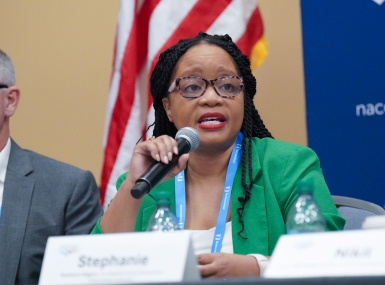Local leaders warn Congress, one size doesn’t fit all in infrastructure spending
Trump Administration's preference for P3s will conflict with rural infrastructure capacity, needs
President Trump caught the attention of public works departments soon after he was elected, stressing the need for an investment in infrastructure during his victory speech in November.
“We’re dealing with very little detail at this point, but P3s (public-private partnerships) are going to be a big part of it,” Rep. Sam Graves (R-Mo.) said at a Capitol Hill Infrastructure Week briefing May 17. “It’s absolutely going to be a big part of it, because that’s what the president wants to see in his package.
“We’re looking at an additional $200 billion in general revenue, and P3s will be a big part of that.”
Graves is chairman of the House Subcommittee on Highways and Transit. The administration’s plan is due out by mid-June, and the House aims to tackle it in September or October, after the summer recess, and, he said, after addressing tax reform.
P3s could figure prominently in the $1 trillion proposal President Trump has promised, but Ramsey County, Minn. Commissioner Jim McDonough pointed out that the tolls necessary for P3s’ viability wouldn’t be sustainable, particularly in rural areas that counties govern.
“NACo endorses a user-pay approach, and public-private partnerships are a key piece of that, but it’s not one-size-fits all,” he said. “There are large parts of our country where that will not work.”
Cleveland, Ohio Councilman Matt Zone added to that sentiment.
“Over the last two decades, 93 percent of all projects that were done with tax-exempt municipal bonds would not have been eligible under the P3 model,” he said. “One of the things that concerns me is that it’s not going to be the perfect model for all communities. It doesn’t work in smaller, impoverished or rural areas.”
Whatever the method, McDonough hammered home that losing the tax-exempt status of municipal bonds would render much of any new funding moot, because the increased cost of borrowing money would reduce the number of projects governments could perform.
The tax-exempt status of municipal bonds has had a target on it since 2012 and is considered an option in tax reform discussions.
“You can’t provide us with tools on one side and take away tools from the other side,” McDonough said. “We need the federal government to be a partner with us.”
Oklahoma City Mayor Mick Cornett did his part to make sure Trump knew that methods were just as important as money when they met at the White House over the winter.
“I told him how important it was that we maintain the tax-free status of municipal bonds,” Cornett said during a Capitol Hill Infrastructure Week briefing. “He assured me it was in his plan, but since I haven’t heard that said since, I would love to hear some reassurance from the White House that they still feel that strongly.”
Graves said “everything is on the table” in terms of figuring out a new funding mechanism to feed the Highway Trust Fund, particularly as increased fuel efficiency is depressing gas tax revenue to the point where it’s become regressive.
“We have vehicles on the road that simply aren’t made for the gas tax; we have to move to a different mechanism,” he said. “It could be vehicle miles traveled, it could be raising the gas tax. It could be a hybrid. If we do replace the gas tax, it will be a replacement, it won’t be another layer on top of the existing tax.”
Sen. Amy Klobuchar (D-Minn.) said that last year’s FAST Act surface transportation funding bill created a strong foundation from which Congress could approach further infrastructure spending, and reduced the pent-up pressure built over years of extensions.
“It gave a steady argument to state legislatures and governments across the country that we did our part and they should do theirs,” she said. “I think it was a good move. We aren’t struggling to make some deal to just make up for something that we hadn’t paid for yet. We have the base money done and that gives us an exciting opportunity at a time when we shouldn’t be governing by crisis.”
Graves expects repatriation of overseas assets to play a part in infrastructure funding. Klobuchar prefers a longer-term solution.
Broadband: A Link to the Future
Infrastructure means more than just roads and bridges, and Montgomery County, Md. Council Vice President Hans Reimer demonstrated that his county is taking that seriously. He participated in a panel discussion May 18, The Importance of Building Broadband in Smart Communities, held at the NACo/NLC Joint Conference Center.
“Broadband is essential. To me,it’s like our responsibility for water, for roads and power,” he said. “It’s essential infrastructure, and to me it’s essential because it’s the gateway to opportunity to everything that’s happening out there, all the benefits of technology and innovation rely on super-high-speed internet.”
Mesa, Ariz. Vice Mayor David Luna shared that sentiment.
“It’s essential for business attraction,” he said. “If we as communities want to bring industry, business leaders, large companies into our community, we have to have the infrastructure in place to attract them, so broadband is important to doing that.”
Even in a large metropolitan county like Montgomery, there are barriers that remain to more thorough and competitive internet wiring. The county is considering a broadband-ready building code, which will prevent real estate developers from signing exclusive agreements with service providers that can often leave secondary providers looking at a $50,000 renovation to install.
“That doesn’t work in anyone’s interest,” Reimer said. “Telephone attachments are also an issue (for spreading broadband infrastructure). The fact that it’s so expensive to get on the telephone poles, makes it one of the single biggest barriers to competition in broadband delivery in our community.
“The notion that we would rent out our poles for $50 a pop, I couldn’t abide by that. There’s a lot more value in our right-of-way than that.”
Attachments
Related News

U.S. House of Representatives introduce Standardizing Permitting and Expediting Economic Development Act
On July 25, U.S. House Committee on Natural Resources Chairman Bruce Westerman (R-Ark.-04) and Rep. Jared Golden (D-Maine-02) introduced the Standardizing Permitting and Expediting Economic Development (SPEED) Act. This bipartisan bill would amend the National Environmental Policy Act (NEPA) to clarify ambiguity and streamline the permitting process.

LUCC members discuss importance of urban transit
Following low ridership during and after the COVID-19 pandemic, investing in urban county transit systems is essential, now more than ever, to cultivate thriving communities, LUCC members said.
Arkansas county expands its future by preserving a 19th-century bridge
Saline County, Ark. is restoring a 134-year-old bridge connecting a 65-mile pedestrian and bike trail spanning from Little Rock to Hot Springs.
